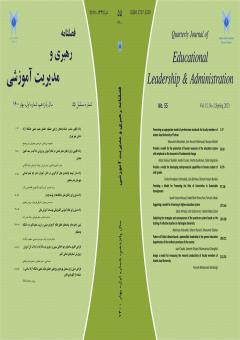The effect of virtual social media on risk taking in students
Subject Areas :maryam talebdoost 1 , Mahnaz Amirpour 2 , Masoud Imanian Ardabili 3
1 - PhD student in Economic Sociology and Development, Department of Social Sciences, Quchan Branch, Islamic Azad University, Quchan, Iran
2 - Assistant Professor, Department of Social Sciences, Quchan Branch, Islamic Azad University, Quchan, Iran
3 - Assistant Professor of Sociology, Department of Social Sciences, Quchan Branch, Islamic Azad University, Quchan, Iran
Keywords: virtual social media, risk taking, Instagram, students.,
Abstract :
Purpose: The aim of the current research was to examine the pathology of virtual social media on the development of risk-taking among students. The method of this research was survey-descriptive and practical in terms of purpose.
Method: The statistical population included 313 high school students of Qochan city who had an Instagram user account. Therefore, the sample size was determined based on the random sampling method of 380 people. The research tool was designed through a researcher-made questionnaire that was the result of the subject literature. For the validity of the tool, its value was 0.88 using the formal method and reliability with Cronbach's alpha test. For data analysis, Friedman's statistical tests were used to prioritize the indicators and how the variables influence the Amos software.
Findings: The findings showed that the highest frequency of reference by Instagram users in the dimension of social-virtual media belongs to the cultural component with a frequency of 313, and in the dimension of sexual risk-taking, it belongs to the component of tendency to sexual relations with a frequency of 313. The prioritization of sexual risk-taking indicators shows that the change of human values and beliefs and the tendency to the opposite sex has the highest average of 4.51, and informing parents has the lowest average of 3.89. Also, sexual risk taking and body management had a significant relationship with Instagram virtual space.
Conclusion: It can be concluded that the use of Instagram media, in addition to the many benefits it has in daily life, can be threatening for students. Therefore, the planners of the education system should be able to reduce the amount of cyberspace threats by building the capacity of students and increasing their media literacy.
اپروز، کمال. کرد، بهمن. (1400). بررسی رابطه بین رفتارهای پرخطر و فضای مجازی با کیفیت زندگی. فصلنامه روانشناسی تحلیلی شناختی، 12(45): 119-107.
احمدی، حبیب. (1384). جامعه¬شناسی انحرافات، تهران: انتشارات سمت.
اکبری، شیما، هاشمی، شهناز. (1395). شبکه¬های مجازی و جوانان علل گرایش جوانان به شبکه¬های اجتماعی در فضای مجازی، سومین همایش ملی راهکارهای توسعه و ترویج علوم تربیتی، روانشناسی، مشاوره و آموزش در ایران، تهران
انصاری، ابراهیم، کیانپور، مسعود، عطایی، پری. (1397). تحلیل جامعه شناختی تأثیر استفاده از فضای مجازی بر فرهنگ شفاهی (مورد مطالعه: شهر اصفهان)، جامعه شناسی کاربردی، 29(1): 40-18.
ایناتلو، مریم. (1395). بر ساخت بدن، جامعهشناسی سبکهای مدیریت بدن جوانان، تهران: نشر جامعهشناسان.
بشیر، حسن، افراسیابی، محمدصادق. (1391). شبکههای اجتماعی اینترنتی و سبک زندگی جوانان؛ مطالعه موردی بزرگترین جامعه مجازی ایرانیان، فصلنامه تحقیقات فرهنگی، 5(1): 62-31.
پوری، احسان. (1390). بررسی نقش و تاثیر فیسبوک بر شکلگیری شبکههای اجتماعی از دیدگاه متخصصان و کارشناسان امور رسانه. پایاننامه کارشناسی ارشد دانشگاه آزاد اسلامی واحد تهران مرکز.
پولادسنج، الهه، بقائی، مهدی. (1400). تاثیر رسانههای اجتماعی بر برنامههای آموزش جنسی جوانان، اولین کنفرانس بینالمللی علوم تربیتی، روانشناسی و علوم انسانی.
تامپسون، جان. (1380). رسانهها و مدرنیته: نظریة اجتماعی رسانهها، ترجمة مسعود اوحدی، تهران: نشر سروش.
حسینیپاکدهی، علیرضا، مرادیان، یعقوب. (1395). تأثیر تبلیغات بازرگانی بر نگرش به مدیریت بدن؛ مورد مطالعه: شهروندان بالای 18 سال کرمانشاه، مجله مطالعات میان فرهنگی، 11(29): 142-113.
خلج آبادی فراهانی، فریده. (1400). بررسی نقش اینترنت و فضای مجازی در هنجار، نگرش و رفتارهای جنسی جوانان شهر تهران، نهمین کنگره ملی آسیبشناسی خانواده و پنجمین جشنواره ملی خانواده پژوهی، تهران.
درویش سروستانی، پریسا، حاصلی، فاطمه (1400). نقش فضای مجازی بر رفتارهای پرخطرجنسی در جوانان(مطالعه موردی: دانشجویان دانشگاه تهران). همایش ملی پژوهشهای نوین در روانشناسی و علوم رفتاری، خمینی شهر.
ذکايي، محمدسعيد. (1386). فرهنگ مطالعات جوانان، تهران: نشر آگاه.
رجبیپور، محمود. (1391). مبانی پیشگیری اجتماعی رشدمدار از بزهکاری اطفال و نوجوانان، چاپ اول، تهران: انتشارات میزان.
Al-Gahtani, S. Geoffrey, S. Hubona, S. Wang, J. (2007). Information Technology (IT) In Saudi Arabia: Culture and the Acceptance and Use of IT, Information & Management, 44, 681-691.
Angela, F. Blair, T. (2010). Effect of Exposure to Media Images on Perceptual Body Image Distortion and Affective Dissatisfaction. retrieved on psych.hanover.
Aparicio-Martinez, P. Perea-Moreno, A.J. Martinez-Jimenez, M.P. Redel-Macías, M.D. Pagliari, C. Vaquero-Abellan, M. (2019). Social Media, Thin-Ideal, Body Dissatisfaction and Disordered Eating Attitudes: An Exploratory Analysis, Int J Environ Res Public Health, 16(21): 4177.
Asmawati, N. (2021). The effect of Instagram in learning English vocabulary. Datokarama English Education Journal, 2(1), 22-34.
Balliet, D., Van Vugt, M. (2011). Sex Differences in Cooperation: A Meta-Analytic Review of Social Dilemmas, Psychological Bulletin, 137 (6), 881–909.
Goodyear, V. A., Boardley, I., Chiou, S. Y., Fenton, S. A., Makopoulou, K., Stathi, A., ... & Thompson, J. L. (2021). Social media use informing behaviours related to physical activity, diet and quality of life during COVID-19: a mixed methods study. BMC public health, 21, 1-14.
Shuai, L., He, S., Zheng, H., Wang, Z., Qiu, M., Xia, W., & Zhang, J. (2021). Influences of digital media use on children and adolescents with ADHD during COVID-19 pandemic. Globalization and health, 17, 1-9.


